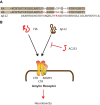Lessons from two prevalent amyloidoses-what amylin and Aβ have in common
- PMID: 23964237
- PMCID: PMC3737661
- DOI: 10.3389/fnagi.2013.00038
Lessons from two prevalent amyloidoses-what amylin and Aβ have in common
Abstract
The amyloidogenic peptide Aβ plays a key role in Alzheimer's disease (AD) forming insoluble aggregates in the brain. The peptide shares its amyloidogenic properties with amylin that forms aggregates in the pancreas of patients with Type 2 Diabetes mellitus (T2DM). While epidemiological studies establish a link between these two diseases, it is becoming increasingly clear that they also share biochemical features suggesting common pathogenic mechanisms. We discuss commonalities as to how Aβ and amylin deregulate the cellular proteome, how they impair mitochondrial functions, to which receptors they bind, aspects of their clearance and how therapeutic strategies exploit the commonalities between Aβ and amylin. We conclude that research into these two molecules is mutually beneficial for the treatment of AD and T2DM.
Keywords: ABAD; Alzheimer's disease; amylin; amyloid; diabetes; mitochondria; proteomics; vaccination.
Figures

References
-
- Assal F., Cummings J. L. (2002). Neuropsychiatric symptoms in the dementias. Curr. Opin. Neurol. 15, 445–450 - PubMed
LinkOut - more resources
Full Text Sources
Other Literature Sources

